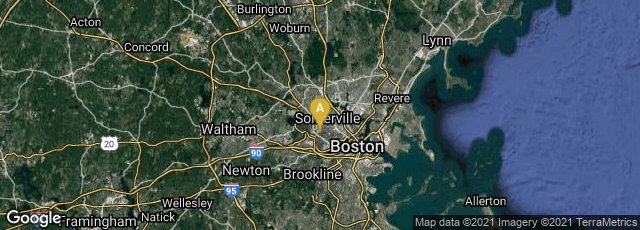

A: Cambridge, Massachusetts, United States
In 1959 Harvard neurophysiologists David H. Hubel and Torsten Wiesel, inserted a microelectrode into the primary visual cortex of an anesthetized cat. They then projected patterns of light and dark on a screen in front of the cat, and found that some neurons fired rapidly when presented with lines at one angle, while others responded best to another angle. They called these neurons "simple cells." Still other neurons, which they termed "complex cells," responded best to lines of a certain angle moving in one direction. These studies showed how the visual system builds an image from simple stimuli into more complex representations. Many artificial neural networks, fundamental components of deep learning, may be viewed as cascading models of cell types inspired by Hubel and Wiesel's observations.
For two later contributions Hubel and Wiesel shared the 1981 Nobel Prize in Physiologist or Medicine with Roger W. Sperry.
". . . firstly, their work on development of the visual system, which involved a description of ocular dominance columns in the 1960s and 1970s; and secondly, their work establishing a foundation for visual neurophysiology, describing how signals from the eye are processed by the brain to generate edge detectors, motion detectors, stereoscopic depth detectors and color detectors, building blocks of the visual scene. By depriving kittens from using one eye, they showed that columns in the primary visual cortex receiving inputs from the other eye took over the areas that would normally receive input from the deprived eye. This has important implications for the understanding of deprivation amblyopia, a type of visual loss due to unilateral visual deprivation during the so-called critical period. These kittens also did not develop areas receiving input from both eyes, a feature needed for binocular vision. Hubel and Wiesel's experiments showed that the ocular dominance develops irreversibly early in childhood development. These studies opened the door for the understanding and treatment of childhood cataracts and strabismus. They were also important in the study of cortical plasticity.
"Furthermore, the understanding of sensory processing in animals served as inspiration for the SIFT descriptor (Lowe, 1999), which is a local feature used in computer vision for tasks such as object recognition and wide-baseline matching, etc. The SIFT descriptor is arguably the most widely used feature type for these tasks" (Wikipedia article on David H. Hubel, accessed 11-10-2014).